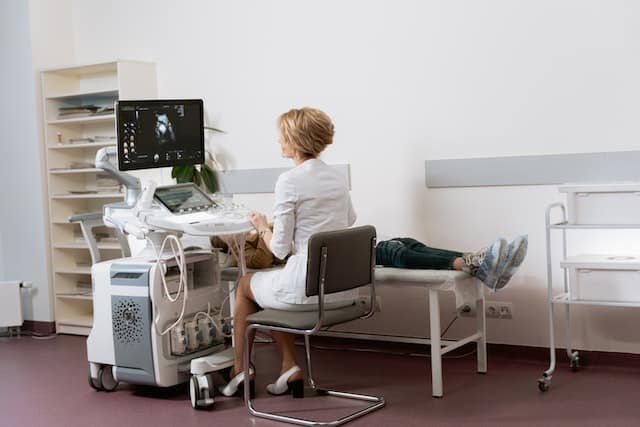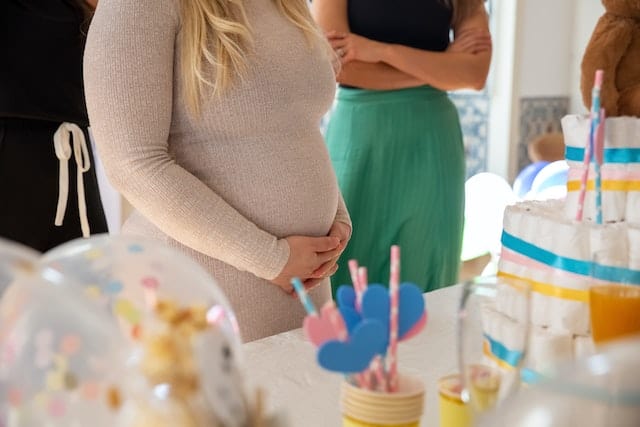Many expectant mothers eagerly await the onset of labor, but sometimes nature needs a little push. Whether it’s because of a medical issue or simply impatience, some women may want to fake contractions on the monitor to induce labor.
While it’s important to note that medical intervention should only be considered when necessary and under the guidance of a healthcare provider, there are non-medical methods that can help bring on labor.
Understanding contractions is crucial to faking them on the monitor. Contractions are the tightening and relaxing of the uterus, and they are a sign that labor is beginning.
The frequency, duration, and intensity of contractions are important factors that healthcare providers use to determine if labor is progressing normally.
By understanding these factors, women can mimic the pattern of contractions on the monitor to give the appearance of going into labor.
Monitoring contractions is a vital part of labor and delivery, and it’s important to know how to accurately fake them on the monitor. There are several ways to do this, including using a TENS machine, nipple stimulation, and acupressure.
These non-invasive methods can help stimulate contractions and mimic the pattern of labor on the monitor. However, it’s important to note that these methods should only be used under the guidance of a healthcare provider and after a thorough discussion of the risks and benefits.
Key Takeaways
- Understanding contractions and how they are monitored is crucial to faking them on the monitor.
- Non-medical methods, such as TENS machines, nipple stimulation, and acupressure, can help stimulate contractions and mimic labor on the monitor.
- It’s important to discuss the risks and benefits of any method with a healthcare provider before attempting to induce labor.
Learn more from another post: Signs Labor Is 24-48 Hours Away
Understanding Contractions
Contractions are a natural part of the labor process and are the result of the uterus tightening and relaxing. They are the way the body prepares for childbirth. Understanding contractions is crucial for women who are close to giving birth.
Contractions cause the cervix to dilate, which is an essential part of the labor process. The cervix must dilate to ten centimeters to allow the baby to pass through the birth canal.
Contractions also help to push the baby down into the pelvis, making it easier for the baby to be born.
There are two types of contractions: uterine contractions and Braxton Hicks contractions. Uterine contractions are the ones that cause the cervix to dilate and are a sign of true labor.
Braxton Hicks contractions are milder and do not cause the cervix to dilate. They are often referred to as “false labor.”
The intensity and duration of contractions increase as labor progresses. Stronger contractions are a sign that the baby is moving down the birth canal and that labor is progressing.
The intensity of contractions is measured on a scale of one to ten, with ten being the most intense.
The intensity and duration of contractions are monitored using a uterine contraction monitor. This device measures the strength and frequency of contractions and can help determine whether a woman is in true labor or experiencing false labor.
Knowing the signs of labor and understanding contractions can help women prepare for childbirth and make the process easier. It is essential to pay attention to the intensity and duration of contractions, as well as any other signs of labor, such as the breaking of the water.
Monitoring Contractions
Monitoring contractions is an essential part of labor and delivery. The healthcare provider will use a contraction monitor to measure the frequency, duration, and intensity of the contractions.
This information is important to ensure the mother and baby are healthy during labor.
The contraction monitor consists of two parts: the toco and the pressure transducer. The toco is a device that is placed on the mother’s abdomen to measure the frequency of the contractions.
The pressure transducer is inserted into the mother’s vagina to measure the intensity of the contractions.
The toco measures the contractions by sensing the changes in pressure on the mother’s abdomen. The pressure transducer measures the intensity of the contractions by measuring the pressure inside the uterus.
Both of these devices are connected to the central viewing station, where the healthcare provider can monitor the contractions and the baby’s heart rate.
During labor, the healthcare provider will also monitor the baby’s heart rate. This is typically done using electronic fetal monitoring (EFM).
EFM measures the baby’s heart rate and the contractions on a monitor. The healthcare provider will look for patterns in the baby’s heart rate to ensure the baby is healthy.
If the healthcare provider is unable to get a good reading with the external monitors, they may recommend internal monitoring. This involves placing a small electrode on the baby’s scalp to measure the baby’s heart rate directly.
In summary, monitoring contractions is an important part of labor and delivery. The healthcare provider will use a contraction monitor to measure the frequency, duration, and intensity of the contractions.
They will also monitor the baby’s heart rate using electronic fetal monitoring. If necessary, they may recommend internal monitoring to get a better reading.
Understanding Pregnancy
Pregnancy is a beautiful and exciting time for most women, but it can also be a challenging experience. It is a time when a woman’s body undergoes significant changes, both physically and emotionally.
The third trimester is a particularly crucial period, as it is the time when the baby is preparing for birth.
During the third trimester, a woman may experience Braxton Hicks contractions, which are mild contractions that prepare the uterus for labor. These contractions can be mistaken for true labor contractions, but they are not as intense or regular.
As the due date approaches, a woman may experience signs and symptoms that indicate that true labor is imminent.
These signs may include a mucus discharge, water breaking, and weight loss. Diarrhea can also be a sign that labor is approaching.
It is essential to prepare for true labor by packing a hospital bag and discussing a birth plan with a healthcare provider. It is also important to stay hydrated and well-rested in the days leading up to the birth.
In conclusion, understanding pregnancy and the signs of true labor can help a woman prepare for the birth of her child. It is essential to stay informed and seek medical advice if any concerns arise during pregnancy.
Faking Contractions
Faking contractions is a common practice among pregnant women who want to speed up their labor process. Contractions are the body’s way of preparing for childbirth, and they are usually monitored through an electronic fetal monitor.
However, some women may want to fake contractions to speed up their labor process.
To fake contractions, one can apply pressure force to the abdomen. This can be done by using the hands or by leaning against a wall or bed. The pressure force should be applied in a rhythmic manner to simulate the pattern of contractions.
Another way to fake contractions is by contorting the abdomen. This can be done by bending forward or backward, or by twisting the torso. The contortion should be done in a rhythmic manner to simulate the pattern of contractions.
It is important to note that faking contractions can be dangerous for both the mother and the baby. It can lead to premature labor, which can result in complications for the baby.
It is also important to note that the electronic fetal monitor can detect fake contractions, and medical professionals can tell if a woman is faking contractions.
In conclusion, while faking contractions may seem like an easy way to speed up the labor process, it is not recommended. It can be dangerous for both the mother and the baby, and it can be detected by medical professionals.
It is important to let the body go through the natural labor process and to trust medical professionals to monitor and assist in the process.
Recognizing False Labor
False labor, also known as Braxton Hicks contractions, can be confusing for expectant mothers. While they can be uncomfortable, they are not a sign of true labor and do not indicate that the baby is ready to be born.
One way to differentiate between false labor and true labor is to pay attention to the timing and intensity of the contractions. False labor contractions are irregular and do not get closer together over time.
They may also be less intense than true labor contractions.
Dehydration can also cause false labor contractions. It is important for expectant mothers to stay hydrated throughout their pregnancy to avoid false labor contractions caused by dehydration.
Preterm labor is a concern for expectant mothers, and false labor can sometimes be a sign of premature labor. If the contractions become more frequent and start to feel more intense, it is important to contact a healthcare provider.
During a pelvic exam, a healthcare provider can check to see if the cervix is effaced or dilated, which can be a sign of true labor. However, false labor contractions do not cause the cervix to efface or dilate.
Overall, it is important for expectant mothers to be aware of the signs of labor and to contact their healthcare provider if they are unsure if they are experiencing true labor or false labor contractions.
Medical Intervention
When a woman is experiencing contractions, healthcare providers use various methods to monitor the progress of labor. They use a toco, or tocodynamometer, to measure the frequency and duration of contractions. They also use an ultrasound to measure the dilation of the cervix.
If a woman’s contractions are not strong enough, her healthcare provider may induce labor by using medication. This medication can cause contractions to become stronger and more frequent.
It can also cause the cervix to dilate more quickly.
If a woman is experiencing pain during labor, her healthcare provider may offer pain relief options. These options can include epidural anesthesia, which numbs the lower half of the body, or other medications that can help to relax the woman.
It is important to note that faking contractions on the monitor can be dangerous. It can lead to unnecessary medical interventions, such as induction of labor or cesarean section. It can also lead to decreased blood flow to the baby and other complications.
The bottom line is that healthcare providers and sonographers are trained to detect false contractions. It is important for women to be honest with their healthcare providers about their symptoms and to trust their medical team to provide appropriate care.
Non-Medical Methods to Induce Labor
There are several non-medical methods that can be used to induce labor. These methods are not scientifically proven, but they may help to stimulate contractions.
Here are some common non-medical methods that women have used to induce labor:
Sex
Sexual intercourse is a common method used to induce labor. Semen contains prostaglandins, which can help to soften the cervix and stimulate contractions. Additionally, orgasm can cause the uterus to contract.
However, it is important to note that sex should only be attempted if the water has not broken and the doctor has given the green light.
Spicy Foods
Some women believe that eating spicy foods can help to induce labor. The theory behind this is that the spicy foods can irritate the digestive system, which can then stimulate the uterus. However, there is no scientific evidence to support this claim.
Acupuncture
Acupuncture is another non-medical method that some women have used to induce labor. Acupuncture involves the insertion of thin needles into specific points on the body.
These points are believed to stimulate the release of hormones that can help to induce labor. However, like spicy foods, there is no scientific evidence to support this claim.
Overall, it is important to note that non-medical methods should only be attempted after consulting with a healthcare provider. Additionally, it is important to remember that every pregnancy is different, and what works for one woman may not work for another.
Understanding the Stomach and Abdomen
The stomach is a muscular sac located in the upper abdomen, between the esophagus and the small intestine. It plays a vital role in the digestive process by breaking down food into smaller particles and mixing it with digestive juices.
The stomach also helps to regulate the rate at which food is released into the small intestine.
During pregnancy, the uterus expands and puts pressure on the stomach and surrounding organs. This can cause discomfort and lead to false contractions on the monitor.
It is important to understand the anatomy of the stomach and abdomen to differentiate between real and fake contractions.
The abdomen is divided into four quadrants: upper right, upper left, lower right, and lower left. Each quadrant contains various organs, including the stomach, liver, pancreas, spleen, small intestine, large intestine, and reproductive organs.
By monitoring the contractions in each quadrant, healthcare providers can determine the location and severity of any discomfort or pain.
Video monitoring can also be used to visualize the contractions and movements of the stomach and abdomen. This can provide valuable information about the timing and intensity of contractions, as well as any changes in fetal position.
However, it is important to note that video monitoring may not always be accurate and should be used in conjunction with other diagnostic tools.
In summary, understanding the anatomy of the stomach and abdomen is crucial for differentiating between real and fake contractions during pregnancy.
By monitoring contractions in each quadrant and using video monitoring when necessary, healthcare providers can provide accurate diagnoses and ensure the safety of both mother and baby.
Frequently Asked Questions
How can I induce contractions naturally?
There are several natural methods that may help induce contractions, such as walking, nipple stimulation, and having sex. However, it is important to consult with your healthcare provider before trying any of these methods.
How can I prepare for labor and delivery?
Preparing for labor and delivery involves attending childbirth classes, creating a birth plan, and packing a hospital bag. It is also important to maintain a healthy diet and exercise routine throughout pregnancy.
What are some common signs of labor?
Common signs of labor include regular contractions, water breaking, and a bloody show. It is important to contact your healthcare provider if you experience any of these signs.
What are the stages of labor?
The stages of labor include the early stage, active stage, and pushing stage. During the early stage, contractions become more frequent and intense. The active stage involves more intense contractions and dilation of the cervix. The pushing stage involves pushing the baby out.
What are some techniques for managing labor pain?
Techniques for managing labor pain include breathing exercises, massage, and epidural anesthesia. It is important to discuss pain management options with your healthcare provider before labor.
What should I expect during labor and delivery?
During labor and delivery, you can expect to experience contractions, push the baby out, and deliver the placenta. Your healthcare provider will monitor you and your baby throughout the process to ensure a safe delivery.
Related Posts:
- What To Wear After Delivery 2?
- How to Clean Out Your Unborn Babys’ System?
- When Do Your Hips Widen During Pregnancy?

Iesha is a loving mother of 2 beautiful children. She’s an active parent who enjoys indoor and outdoor adventures with her family. Her mission is to share practical and realistic parenting advice to help the parenting community becoming stronger.



